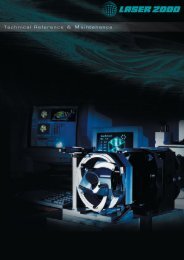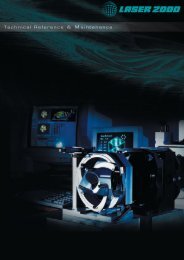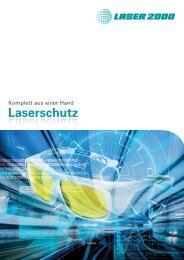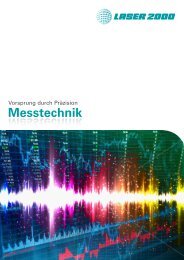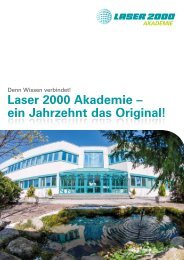Semrock Master Catalog 2018
Semrock Master Catalog 2018
Semrock Master Catalog 2018
You also want an ePaper? Increase the reach of your titles
YUMPU automatically turns print PDFs into web optimized ePapers that Google loves.
Polarization Filters<br />
Common Specifications<br />
Property Value Comments<br />
Guaranteed Transmission > 95% p-polarized light<br />
Contrast 1,000,000:1<br />
Blocking See table on page 86<br />
Ratio of transmission through two identical aligned<br />
polarizers to transmission through same pair of<br />
crossed polarizers<br />
Nominal Angle of Incidence 45° AOI tolerance (See table on page 86)<br />
Laser Damage Threshold 1 J/cm² @ 532 nm 10 ns pulse width p-pol (See page 108)<br />
Substrate Material<br />
Dimensions & Tolerance<br />
Ultra-low autofluorescence fused silica<br />
25.2 mm x 35.6 mm x 2.0 mm +/- 0.1 mm<br />
25.0 mm x 2.0 mm +/- 0.1 mm<br />
Mount options on page 86 for 25.2 x 35.6 mm size<br />
25.0 mm (unmounted)<br />
Clear Aperture ≥ 85% Elliptical, for all optical specifications<br />
Transmitted Wavefront Error < λ/4 RMS at λ = 633 nm Peak-to-valley error < 5 x RMS value measured within<br />
clear aperture<br />
Beam Deviation ≤ 10 arc seconds Measured per inch<br />
Surface Quality 40-20 scratch-dig Measured within clear aperture<br />
Orientation<br />
TECHNICAL NOTE<br />
Thin-film Plate Polarizers<br />
Coating (Text) towards light<br />
Coating (Text) away from light<br />
For use as a polarizer<br />
For use as an analyzer<br />
A “polarizer” transmits a single state of polarization of light while absorbing, reflecting, or deviating light with the orthogonal<br />
state of polarization. Applications include fluorescence polarization assays and imaging, second-harmonic-generation imaging,<br />
polarization diversity detection in communications and rangefinding, and laser materials processing, to name a few. Polarizers<br />
are characterized by the “contrast ratio,” or the ratio of the transmission through a pair of identical aligned polarizers to<br />
the transmission through the same pair of crossed polarizers. Contrast ratios typically vary from about 100:1 to as large as<br />
100,000:1.<br />
Three of the most common high-contrast polarizers<br />
are shown in the diagram on the right. Thin-film plate<br />
polarizers, like those made by <strong>Semrock</strong>, are based on<br />
interference within a dielectric optical thin-film coating on<br />
a thin glass substrate. In birefringent crystal polarizers,<br />
different polarization orientations of light rays incident on<br />
an interface are deviated by different amounts. In “Glan”<br />
calcite polarizers, extinction is achieved by total internal<br />
reflection of s-polarized light at a crystal-air gap (Glanlaser)<br />
or crystal-epoxy gap (Glan-Thompson). Glass film polarizers<br />
selectively absorb one orientation of linearly polarized light more strongly than the other.<br />
s & p<br />
Thin-film plate polarizers have a number of unique advantages relative to other types of polarizers, including superior<br />
s only<br />
transmission and optical quality, low scattering, wavefront distortion, and s beam & p deviation that can cause beam walk during<br />
s only<br />
rotation. They can be made with excellent environmental reliability, the highest s & p laser damage thresholds, and large aperture<br />
s & p<br />
p only s & p<br />
sizes (inches). And they naturally function as beamsplitters with a 90º beam deviation T of the blocked polarization. Unlike<br />
p<br />
birefringent crystal polarizers, thin-film plate polarizers tend to function over only a range of wavelengths s since they are based<br />
on multiwave interference, and thus they are best suited for laser applications or for systems Thin-film with Plate limited signal band. Birefringent Crystal<br />
p only<br />
s & p<br />
Polarizer λ<br />
Polarizer<br />
Birefringent crystal polarizers tend to have very limited aperture size due to the high cost of growing good optical-quality<br />
Polarizing Bandpass Filter<br />
crystals, and they are not well suited for imaging applications. Besides a somewhat limited wavelength range, the main<br />
limitations of glass film polarizers are low transmission of the desired light and low optical damage threshold, making them<br />
unsuitable for many laser applications.<br />
s only<br />
Thin-film Plate<br />
Polarizer<br />
p only<br />
s & p<br />
s only<br />
Birefringent Crystal<br />
Polarizer<br />
s only<br />
p only<br />
s & p<br />
Glass Film<br />
Polarizer<br />
p only<br />
p only<br />
s & p<br />
NIR Filters Mirrors Polarizers<br />
Edge<br />
Filters<br />
Dichroic<br />
Beamsplitters<br />
Laser-line<br />
Filters<br />
Laser Diode<br />
Filters<br />
Notch<br />
Filters<br />
p only<br />
Glass Film<br />
Polarizer<br />
<strong>Semrock</strong>’s ion beam sputtering technology has enabled breakthrough<br />
improvements in performance of traditional thin-film plate polarizers.<br />
Foremost among these is contrast – <strong>Semrock</strong> polarizers are guaranteed<br />
to achieve higher than 1,000,000:1 contrast, rivaled only by the lowertransmission<br />
and low optical damage-threshold glass film polarizers. And,<br />
only <strong>Semrock</strong> polarizers can achieve unique spectral performance like our<br />
patented “polarizing bandpass filters” (see figure on the right).<br />
s & p<br />
s & p<br />
s only<br />
s & p<br />
p only<br />
Polarizing Bandpass Filter<br />
T<br />
p<br />
s<br />
λ<br />
Lamp Clean-up<br />
Filters<br />
87<br />
More




